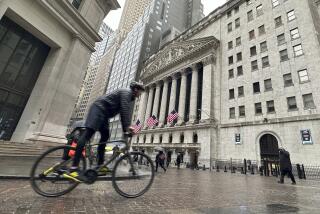With Fed poised to act, here’s how investors can prepare for higher rates

Many economists believe the Fed is eager to begin raising rates, if just to give itself some ammo in the event of another crisis.
It has been nearly a decade since investors have had to contend with the Federal Reserve raising interest rates. Or, from savers’ viewpoint, it has been that long since the Fed did them a favor.
But Wall Street’s No. 1 obsession this year is guessing how soon the central bank will start lifting its benchmark short-term rate from near zero — and, more important, how financial markets will fare when that day comes.
Predictions of investors’ reaction range from Armageddon to a nonevent.
Many economists believe the Fed is eager to begin raising rates, if just to give itself some ammo in the event of another crisis. If its key rate were back to 1%, for example, policymakers would be able to cut again to zero to offset an unexpected economic calamity.
The justification for boosting rates, however, has to be rooted in an improving economy.
“I believe a decision to raise rates would signify very clearly that the U.S. economy has made great progress in recovering from the trauma of the financial crisis,” Fed Chairwoman Janet Yellen said in June.
She added that she expected a rate hike to be “appropriate later this year.”
What will happen with your investment nest egg when the Fed finally pulls the trigger? The cash portion of any portfolio should begin earning a better interest rate.
The bond market and stock market, however, will have to brace for potentially dramatic upheaval. Here’s a look at what investors in bonds and stocks could face, and how to prepare:
Bonds and bond mutual funds
The bond market’s reaction to rising rates is the $42-trillion question. That’s the amount of government, business and bank debt outstanding now.
A significant chunk of that debt is owned by individuals, who have had a ravenous appetite for bonds since the crisis. By keeping short-term rates near zero since 2008, the Fed has pushed investors and savers out of low-risk assets, such as bank certificates of deposit, and into higher-yielding but riskier assets such as Treasury, corporate and municipal bonds.
With banks paying minuscule yields on deposits, Americans have slashed the sum they keep in small CDs (those under $100,000) to $466 billion now from $1.28 trillion at the end of 2008. In that same period, assets of bond mutual funds have more than doubled, to $3.5 trillion.
But the Fed also can be bond owners’ worst enemy. If the central bank starts pushing up short-term rates, the risk is that longer-term rates will rise as well. If that happens, existing bonds issued at fixed rates automatically drop in value.
That has already begun to happen. Amid growing expectations of a Fed hike in the fall, the yield on the benchmark 10-year Treasury note has jumped from 1.64% in February to 2.39% as of last week. One result: Investors who own the popular Vanguard Total Bond Market Index mutual fund, which owns a wide variety of bonds, have seen their share price drop 1.6% year to date. Though the investors continue to earn interest on the bonds in the portfolio, that hasn’t been enough to offset the drop in principal.
So the fund’s “total return,” counting principal change and interest, is a negative 0.3% year to date.
If longer-term yields should continue to rise, bond owners’ losses would deepen. The big unknown is whether investors would flee bonds if they suffered a long string of quarterly losses.
Investors also face another threat to their bond holdings that doesn’t necessarily hinge on the Fed’s rate moves. It’s the risk of too many sellers trying to exit at once, and too few buyers on the other side.
In part, that “illiquidity” threat is a function of bank re-regulation since 2008. To reduce risk-taking, as directed by regulators, many big banks no longer act as a bond middleman willing to buy when others are selling.
“Some of the things that the government considered risky activities provided liquidity to the markets,” said Michael DePalma, an investment manager at AllianceBernstein in New York.
A deluge of selling in an illiquid market could mean bond yields would have to rise drastically, and quickly, to finally bring in buyers.
Even as Wall Street imagines worst-case scenarios for bonds, many economists believe the Fed will raise short-term rates just two or three times, a quarter-point each, then stop — because the economy is too fragile to handle much higher rates, they say, and because inflation remains tame.
Still, the problem is predicting how bond investors would react to the initial increase. Without a crystal ball, there are some basic moves individual investors in bonds can make to protect themselves:
•First, if you own a bond fund, check its “duration” or “average maturity” on the fund’s website. That tells you whether the fund owns mainly longer-term bonds or shorter-term bonds. Typically, the longer the duration or average maturity, the greater the drop in the fund’s principal value if interest rates rise. A fund with an average duration of two years, for example, would be much less at risk from rising rates than a fund with an average duration of seven years.
The trade-off is that longer-term bonds pay higher interest rates than shorter-term bonds. So you have to give up some yield to protect your principal.
If you own individual bonds and expect to hold them until they mature, ask yourself: Do you care how their market value fluctuates in the interim, as long as you get their face value back at maturity?
•Second, gauge the quality of your bonds. Some fund managers believe that desperate investors have pushed yields on lower-quality bonds down to dangerous levels, and that those will be the first kinds of bonds investors quickly flee if the Fed starts raising rates.
“You’re not being paid to take risk,” warns Tad Rivelle, co-manager of the Los Angeles-based Metropolitan West Total Return bond fund. Rivelle and his team have slashed the fund’s holdings of corporate “junk” bonds to between 2% and 3% of assets, from 12% at their peak. Instead, the fund has bulked up on high-quality U.S. home mortgage bonds and commercial mortgages, Rivelle said.
•Third, if you can’t stand the thought of losing any money in bonds, consider moving part of that investment into safe cash accounts. Laila Pence, head of Pence Wealth Management in Newport Beach, said her typical client’s portfolio now is 10% to 20% in cash, compared with 5% to 7% two to three years ago.
“We’ve replaced a lot of our bond portfolios with cash,” she said, with the idea of waiting to buy higher-yielding bonds later if rates rise.
Stocks and stock mutual funds
Cheap money has been a crucial element powering the stock bull market since March 2009. So what happens if money gets more expensive?
In one camp are unapologetic bulls such as Brian Belski, chief investment strategist at BMO Capital Markets in New York. The stock market, he says, will buy what the Fed’s Yellen says about higher interest rates: that they’re a sign of an improving economy, which also should point to stronger corporate earnings ahead.
Historically, “some of the best and most consistent average returns occurred when interest rates were rising from very low levels — as is currently the case,” Belski said.
What’s more, market bulls note that one of the biggest threats to stocks and bonds in the long run is high inflation. If the net effect of Fed rate hikes is to convince investors that there’s no chance of inflation becoming a problem — because the economy can’t overheat — in theory that should hold down longer-term interest rates and bolster stocks.
In the opposing camp are analysts including Robert Johnson, whose new book, “Invest With the Fed,” looks at central bank policy since 1966 and how markets have fared.
His conclusion: “The stock market’s performance is dramatically better when the Fed is in an expansive period [with credit] versus when it’s in a restrictive period,” said Johnson, who heads the American College for Financial Services in Bryn Mawr, Pa. Higher rates raise companies’ borrowing costs and also mean that cash and new bonds pay more, offering more competition for stocks.
And although one bullish argument for markets is that the Fed will stop after just a few small rate increases, that may not mean much, Johnson said: “We found that it’s not the level of rates that matters but the direction.”
Still, it’s also worth noting that the global economy and markets have never been in the situation they’re in today, which makes it tougher to imagine what’s next. For one, even if the Fed begins to raise rates, central banks in much of the rest of the world — including Europe, Japan and China — show no sign of following suit. That could act as a weight on U.S. bond yields if foreign investors turn to the U.S. for better yields.
In the face of higher interest rates, most financial advisors would never suggest that clients abandon U.S. stocks entirely. But at a minimum, analysts say investors should prepare for a rockier road for equities as the economic expansion ages and stock prices hold near high levels relative to earnings.
“When you get to the second half of the business cycle you just have more volatility,” said Anthony Valeri, investment strategist at LPL Financial in San Diego.
One of his recommendations is to focus on big-name U.S. stocks that can benefit both from economic growth at home and also any pickup abroad.
But many American multinationals struggled in the first half of this year, in part because expectations of rising U.S. interest rates drove up the dollar’s value against most other currencies. That devalues sales and earnings U.S. companies generate overseas. Fed rate hikes could push the greenback up further.
Wary of the dollar, some investors have turned to shares of smaller American companies, many of which do most of their business domestically. The small-stock Russell 2000 index is up 3.6% year to date, beating the 0.9% gain of the blue-chip Standard & Poor’s 500.
Belski and others, however, see the economic environment ultimately benefiting bigger, dividend-paying companies as many investors look for both growth and income.
Other advisors are looking for ways to boost returns in what could be a tough backdrop for Wall Street if the Fed lifts rates.
Mike Amash, senior vice president at Westmount Asset Management in Century City, said his firm believes that the rebound in European stocks isn’t over, despite fears about the future of Greece.
“We continue to think you get more bang for your buck for the next 12 months in Europe than in the U.S.,” he said.
Another opportunity is in so-called frontier markets, Amash said. Though high-risk, they also offer better growth potential than struggling emerging markets such as Brazil and Russia. Westmount uses frontier mutual funds including Wasatch Frontier Emerging Small Countries, which invests in companies in countries including Nigeria, Vietnam, Bangladesh and Kuwait.
Jeffrey Gundlach, head of DoubleLine Capital in Los Angeles, has told his investors that he expects gold to surprise people this year, after falling out of favor in the last three years. He thinks the price could rise to about $1,400 an ounce from $1,163 now.
As for the threat of higher interest rates, Gundlach doubts that there will be significant rate shocks for another few years, given the economic backdrop. He quotes Ernest Hemingway’s line in “The Sun Also Rises” about how one goes bankrupt: “Two ways. Gradually and then suddenly.”
After 30 years of mostly falling interest rates, “There’s a lot of evidence that rates have started the ‘gradually’ phase” of rising again, Gundlach said. “But the ‘suddenly’ phase may not come for a few more years.”






